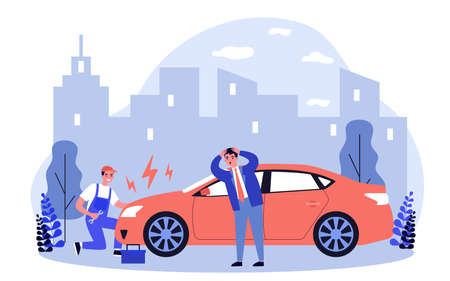1. Understanding Accident Cars in the Indian Context
For Indian car buyers, especially those looking at the pre-owned market, understanding what constitutes an accident car is crucial for making a smart purchase decision. In the Indian automotive landscape, an “accident car” typically refers to a vehicle that has sustained damage from road mishaps, collisions, or other unforeseen incidents. Such incidents can range from minor fender-benders to major accidents involving structural or chassis damage. Common causes of accidents in India include heavy traffic congestion, poorly maintained roads, unpredictable weather conditions during monsoon seasons, and sometimes, non-compliance with traffic rules. The impact of these accidents on a vehicles integrity can be substantial—damaged vehicles may have compromised structural safety, misaligned frames, or faulty airbags and electronics. Additionally, even after repairs, an accident history significantly affects a car’s resale value in India. Potential buyers tend to be wary of such vehicles due to concerns about hidden defects and reduced safety standards. Therefore, having a clear understanding of how accident history impacts both the reliability and the financial worth of a vehicle is essential for every Indian buyer navigating the used car market.
2. Telltale Signs of Accident Repaired Cars
When inspecting a used car in India, especially in the pre-owned market, it is crucial to identify signs that indicate accident repairs. Visual inspection is the first line of defence for Indian buyers, as many accident-damaged vehicles are cosmetically restored before resale. Below are key strategies tailored for Indian conditions:
Visual Inspection Strategies for Indian Vehicles
Check for Uneven Panel Gaps
Consistent panel gaps are a sign of factory assembly. In India, if you notice irregular gaps between doors, bonnet, or boot, it may indicate improper repair after an accident. Use your fingers to feel the spaces — they should be uniform across all panels.
Look for Mismatched Paint
Due to environmental factors and diverse paint suppliers in India, repainted sections can often appear slightly different in shade or gloss. Inspect the vehicle under natural daylight and compare adjacent panels. A mismatch could signal bodywork done after a collision.
Inspect for Welding Marks and Non-Original Seals
Original welding on Indian cars is usually neat and uniform. Check door sills, engine bays, and boot edges for rough welds or excessive sealant application. Unprofessional welding or overuse of sealant indicates post-accident structural repairs.
Spot Replacement Parts
Many accident-damaged cars in India have non-genuine replacement parts installed to reduce costs. Look out for non-OEM logos, missing manufacturer stamps, or labels with different fonts or languages.
Common Visual Clues Table
| Inspection Area | Telltale Sign | What It Could Indicate |
|---|---|---|
| Panel Gaps | Uneven width | Poor alignment after repair |
| Paint Finish | Mismatched colour/texture | Partial repainting post-accident |
| Weld Areas | Rough/irregular welds | Non-factory bodywork repairs |
| Bolt Heads & Seals | Scratches/changed seals | Dismantling during repair/replacement |
| Replacement Parts | No OEM markings/different fitment | Use of aftermarket components |
By carefully examining these visual clues, Indian buyers can significantly reduce the risk of unknowingly purchasing an accident-repaired vehicle. Always combine these strategies with further mechanical and documentation checks for comprehensive evaluation.

3. Mechanical and Structural Evaluation
Technical Checks for Frame Damage
When inspecting a used car in India, especially to identify if it has been involved in an accident, checking for frame damage is crucial. Indian workshops typically rely on basic yet effective tools such as measuring tapes, plumb lines, and frame gauges. Start by measuring the diagonal distances between key mounting points in the engine bay and undercarriage. Uneven measurements or visible signs of welding and patchwork indicate previous structural repairs, which are red flags for major accidents.
Suspension Issues: Signs & Simple Tests
The suspension system often bears the brunt of collision impacts. To check for issues, Indian mechanics commonly use the bounce test—firmly press down on each corner of the vehicle and observe how it returns to its original position. Excessive bouncing suggests worn shock absorbers or misaligned suspension components. Also, listen for unusual noises during a short drive over typical Indian road bumps, which may reveal hidden damage.
Alignment Problems: Workshop-Level Diagnostics
Wheel alignment is another area that can reveal an accident history. At many Indian workshops, technicians use alignment rods or simple string methods to check if all four wheels are properly aligned. If the steering wheel is off-centre when driving straight or if there is uneven tyre wear, these are classic signs of alignment problems—often a result of previous accidents or improper repairs.
Practical Advice for Indian Buyers
While high-end diagnostic equipment may not always be available, these basic checks can be performed at most Indian garages or even at home with minimal tools. Always insist on a thorough inspection before making a purchase decision. Involve a trusted local mechanic who is familiar with common accident repair practices in your region to get a clear assessment of the vehicle’s mechanical and structural integrity.
4. Document Verification and History Checks
When evaluating a used car in India, thorough document verification is essential to avoid accident vehicles or legal complications. This process goes beyond just checking the Registration Certificate (RC); buyers should also verify insurance history, service records, and leverage digital tools specific to Indian practices.
RC Verification
The Registration Certificate is the primary proof of ownership and vehicle identity. Ensure that all details such as chassis number, engine number, owner’s name, and address match the physical vehicle. Pay special attention to any changes in registration or ownership, which could indicate past incidents or transfers due to accidents.
Insurance History Review
Reviewing insurance documents reveals if the car has been involved in major accidents or claims. Request comprehensive insurance policy papers for at least the last three years. Look for:
- Claim frequency: Multiple claims may suggest repeated damage or repairs.
- Type of claims: Major accidental claims can be a red flag for structural issues.
- NIL/NCB (No Claim Bonus): A high NCB indicates no recent claims, which is generally positive.
Service Records Analysis
Legitimate service records from authorised workshops or dealerships help trace the car’s maintenance history. Consistent servicing at scheduled intervals suggests proper upkeep. Be wary if service records are missing, incomplete, or only available after certain dates – this could hide accident repairs or odometer tampering.
Regional Practices: e-Challan & Digital Tools
Indian buyers should utilise regional resources for extra assurance:
| Tool/Resource | Description | How to Use |
|---|---|---|
| e-Challan Portal | Online database of traffic violations linked to the vehicle’s registration number. | Visit official state e-challan websites, enter vehicle number to check for accident-related challans or penalties. |
| VAHAN Portal | Government portal offering details on RC status, ownership changes, fitness certificate validity. | Access VAHAN website, input registration number for comprehensive data. |
| Vehicle History Apps (e.g., CARS24, Droom History) | Third-party apps aggregating public and private data on Indian vehicles’ accident and service history. | Download app, scan QR code or enter vehicle details to access reports including past accidents and service logs. |
Pro Tip: Regional Variations Matter
Laws and digital record availability can differ between Indian states. Always cross-verify with local RTOs and use state-specific portals when possible for maximum transparency.
5. Expert Assessment: When to Involve a Mechanic
While basic checks can help you spot some signs of previous accidents, a thorough inspection by a qualified mechanic or an authorised service centre is crucial for Indian used car buyers seeking peace of mind. Professional mechanics possess advanced tools and experience to detect hidden damages that might not be visible during a routine check—such as frame misalignment, engine mount issues, or improper airbag deployment. In India, it is advisable to choose mechanics who have experience with your vehicle’s make and model or opt for authorised brand service centres where possible.
Why Consult a Trusted Local Mechanic?
A trusted local mechanic understands the unique driving conditions, climate impact, and common accident patterns found in Indian cities like Mumbai, Delhi, Bengaluru, and Chennai. They are familiar with typical repair jobs done locally and can identify substandard repairs or use of non-genuine parts, which are unfortunately prevalent in the Indian second-hand market. Consulting such experts helps ensure that you do not end up with a car carrying hidden safety risks or unexpected future expenses.
Recommended Steps for Evaluation
- Ask for referrals from friends or family for reliable mechanics or workshops.
- Visit authorised service centres if you are considering premium brands like Maruti Suzuki, Hyundai, Tata Motors, Honda, or Mahindra.
- Request a comprehensive inspection report covering chassis integrity, suspension, electricals, and paint quality.
Typical Costs in Indian Cities
The cost of expert vehicle evaluation varies across Indian metro cities:
- General mechanic inspection: ₹500 – ₹1,500
- Authorised service centre full inspection: ₹2,000 – ₹5,000 (depending on brand)
- Advanced diagnostic scans (OBD): ₹800 – ₹2,000
While these costs may seem additional at first glance, they offer significant value by potentially saving you from expensive post-purchase repairs and ensuring the safety of your investment. Always insist on a written report after evaluation to support your negotiation or decision-making process when buying a used car in India.
6. Negotiation & Legal Considerations
Once you have identified signs of an accident car, use your findings strategically during price negotiations. Highlight repair history, mismatched panels, or any evidence of structural damage to justify a lower offer. In the Indian context, it is common for buyers to negotiate aggressively; however, always maintain respect and patience during discussions with the seller.
Leverage Your Inspection Report
Present your inspection observations clearly and factually. Mention specific issues such as replaced doors, frame welds, or paint inconsistencies found during your evaluation. If you have obtained a mechanic’s report, use this as concrete evidence to support your negotiation points.
Understand RTO Disclosures
Check the Registration Certificate (RC) and verify if the car has been re-registered after a major accident or insurance claim. The Regional Transport Office (RTO) in India maintains these records. Always request Form 35 and Form 29/30 when transferring ownership to ensure there are no hidden hypothecation or pending dues from previous loans.
NOC Rules
If the vehicle comes from another state, ensure that a valid No Objection Certificate (NOC) is provided by the seller. This is essential for smooth transfer of ownership and compliance with local RTO regulations. Without an NOC, you may face legal hurdles or fines later on.
Regional Legal Norms
Different states in India may have unique requirements regarding accident car disclosures and title transfers. For example, Maharashtra and Karnataka have stricter documentation norms compared to some northern states. Always consult the local RTO website or seek advice from a licensed agent for region-specific guidelines before finalising any deal.
By combining technical inspection insights with an understanding of Indian legal procedures, you can negotiate confidently and protect yourself from future liabilities when buying a used car in India.

